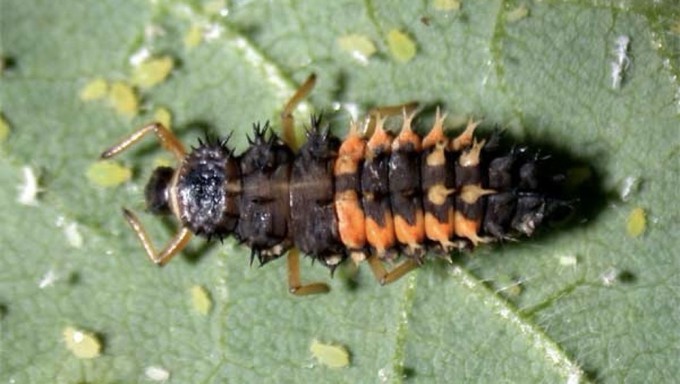
Yolo County master gardeners offer free online workshop on insect, disease identification

Lady beetle larvae like this one are scary looking, but they're voracious eaters of aphids. Courtesy University of Wisconsin
Is that a good guy or a bad guy? That’s my first thought when I see an unfamiliar bug in my garden.
Some good guys – such as lady beetle larvae – look pretty scary, while some beauties bring trouble. (For example, the five-spotted hawk moth starts out as a tomato hornworm.)
Learn how to tell the difference between good and bad bugs as well as how to identify common plant diseases during a free Zoom workshop, presented by the UCCE master gardeners of Yolo County.
Set for 3 p.m. Thursday, Jan. 11, “The Good, The Bad and The Ugly: Insects and Diseases Every Gardener Should Know” will help gardeners throughout the greater Sacramento area better identify what’s bugging their plants – especially in the vegetable garden.
“Experienced Yolo County Master Gardener Mike Kluk will lead the discussion, which will cover a variety of insects commonly found in the garden, both beneficials and bad guys, and common diseases,” say the master gardeners. “The emphasis will be on insects and diseases that have the most impact on vegetable gardens, although most of the information will be relevant to ornamentals as well.”
This one-hour seminar is immediately practical. For example, what’s eating your cabbage? More than 20 different kinds of bugs could be the culprits (plus some mammals, too). Find out how to spot tell-tale signs.
Proper identification of pests and diseases is key to treatment, control and prevention, note the master gardeners. By being able to tell the good bugs from the bad ones, gardeners can support beneficial insects that help their plants while effectively containing pest infestations with little or no chemicals.
No advance registration is necessary; just Zoom on in. Here’s the Zoom link: https://ucanr.zoom.us/j/98806256671.
Details and more information on Yolo County master gardeners: https://yolomg.ucanr.edu/.
Comments
0 comments have been posted.Sacramento Digs Gardening to your inbox.
Sites We Like
Garden Checklist for week of July 21
Your garden needs you!
* Keep your vegetable garden watered, mulched and weeded. Water before 8 a.m. to reduce the chance of fungal infection and to conserve moisture.
* Feed vegetable plants bone meal, rock phosphate or other fertilizers high in phosphate to stimulate more blooms and fruiting. (But wait until daily high temperatures drop out of the 100s.)
* Don’t let tomatoes wilt or dry out completely. Give tomatoes a deep watering two to three times a week.
* Harvest vegetables promptly to encourage plants to produce more. Squash especially tends to grow rapidly in hot weather. Keep an eye on zucchini.
* Pinch back chrysanthemums for bushy plants and more flowers in September.
* Remove spent flowers from roses, daylilies and other bloomers as they finish flowering.
* Pinch off blooms from basil so the plant will grow more leaves.
* Cut back lavender after flowering to promote a second bloom.
* It's not too late to add a splash of color. Plant petunias, snapdragons, zinnias and marigolds.
* From seed, plant corn, pumpkins, radishes, winter squash and sunflowers.